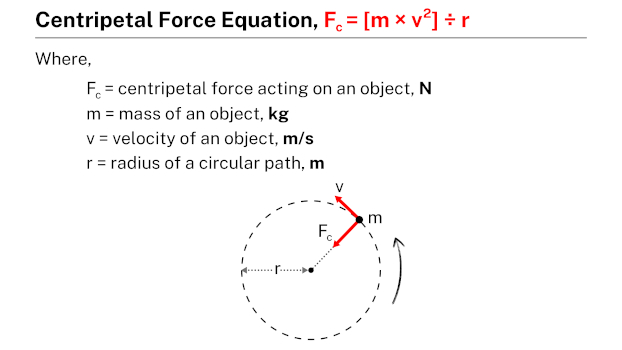
Centripetal force is the force that keeps an object moving in a circular path, directed towards the center of the circle. In simpler terms, it’s the inward force that makes an object follow a curved trajectory instead of moving in a straight line. For example, when you swing a ball attached to a string around your head, the tension in the string acts as the centripetal force, pulling the ball towards the center and keeping it in circular motion. Without this force, the ball would fly off in a straight line due to inertia. Centripetal force is essential in various contexts, from the orbits of planets around the Sun to the functioning of car tires when taking a turn on the road.
The equation for centripetal force (Fc) is given by:
$$F_{c} = \frac{mv^{2}}{r}$$where m is the mass of the object, v is the velocity of the object, and r is the radius of the circular path. This equation quantifies the amount of force required to keep an object moving in a circular trajectory at a constant speed.
Practice problems
Problem #1
Determine the centripetal force acting on a car of mass 1000 kg as it moves in a circular path with a speed of 1.8 km/h. The radius of the circular path is 10 m.
Solution
Given data:
- Centripetal force acting on a car, Fc = ?
- Mass of a car, m = 1000 kg
- Velocity of a car, v = 1.8 km/h = 0.5 m/s
- Radius of a circular path, r = 10 m
Applying the formula:
- Fc = (m × v2) ÷ r
- Fc = [1000 × (0.5)2] ÷ 10
- Fc = 250 ÷ 10
- Fc = 25 N
Therefore, the centripetal force acting on a car is 25 N.
Problem #2
Find the centripetal force acting on a boy of mass 30 kg who is enjoying a merry-go-round ride. The boy sits on a merry-go-round rotating in a circular path with a radius of 6 m and a speed of 2 m/s.
Solution
Given data:
- Centripetal force acting on a boy, Fc = ?
- Mass of a boy, m = 30 kg
- Radius of a circular path, r = 6 m
- Velocity of a boy, v = 2 m/s
Applying the formula:
- Fc = (m × v2) ÷ r
- Fc = [30 × (2)2] ÷ 6
- Fc = 120 ÷ 6
- Fc = 20 N
Therefore, the centripetal force acting on a boy is 20 N.
Problem #3
Calculate the centripetal force acting on a truck weighing 2500 kg, which moves with a speed of 1.2 km/h in a circular path of radius 15 m.
Solution
Given data:
- Centripetal force acting on a truck, Fc = ?
- Mass of a truck, m = 2500 kg
- Velocity of a truck, v = 1.2 km/h = 0.33 m/s
- Radius of a circular path, r = 15 m
Applying the formula:
- Fc = (m × v2) ÷ r
- Fc = [2500 × (0.33)2] ÷ 15
- Fc = 272.25 ÷ 15
- Fc = 18.15 N
Therefore, the centripetal force acting on a truck is 18.15 N.
Problem #4
Determine the centripetal force acting on a sports bike weighing 140 kg as it moves in a circular path with a radius of 25 m and a speed of 2.5 km/h.
Solution
Given data:
- Centripetal force acting on a sports bike, Fc = ?
- Mass of a sports bike, m = 140 kg
- Radius of a circular path, r = 25 m
- Velocity of a sports bike, v = 2.5 km/h = 0.69 m/s
Applying the formula:
- Fc = (m × v2) ÷ r
- Fc = [140 × (0.69)2] ÷ 25
- Fc = 66.654 ÷ 25
- Fc = 2.6 N
Therefore, the centripetal force acting on a sports bike is 2.6 N.
More topics
- Compression (physics)
- Net force
- Magnetism
- Centripetal force
- Centrifugal force
- Spring force
- Tension (physics)
- Electric force
External links
- Centripetal Force Calculation – HyperPhysics Concepts
- 6.3 Centripetal Force – University Physics Volume 1 – OpenStax
- Centripetal Force Calculator – Omni Calculator
- Centripetal Force – Summary – The Physics Hypertextbook
- Centripetal Force – University of Notre Dame
- Centripetal force – Wikipedia
- Centripetal Force: Definition, Formula & Examples – Study.com
- 6.3: Centripetal Force – Physics LibreTexts
- 6.3 Centripetal Force – General Physics Using Calculus I – UCF Pressbooks
- Centripetal Force – CK-12
- The Centripetal Force Requirement – The Physics Classroom
- Centripetal Force and Velocity : Formula – Vaia
- AP Physics 1 : Centripetal Force and Acceleration – Varsity Tutors
- Centripetal and Centrifugal Acceleration Force – The Engineering ToolBox
- How to Find Centripetal Force – Sciencing
- What is a centripetal force? (article) – Khan Academy
- What Is Centripetal Force? Definition and Equations – ThoughtCo
- Centripetal Force: Definition, Examples, & Equation – Science Facts
- Centripetal Force Calculator – CalcTool
- Centripetal Force – Dummies
- Centripetal Force Formula – SoftSchools.com
- Centripetal Force Calculator – Calculator Academy
Deep
Learnool.com was founded by Deep Rana, who is a mechanical engineer by profession and a blogger by passion. He has a good conceptual knowledge on different educational topics and he provides the same on this website. He loves to learn something new everyday and believes that the best utilization of free time is developing a new skill.
